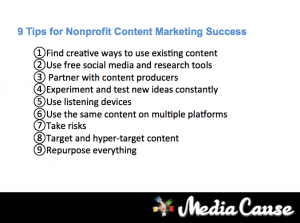When it comes to standing out online, your best bet is to offer your own original content. Blog posts or tweets that revolve around your unique ideas will make you a standout candidate.
But the truth is, not everyone has the time, writing ability or even confidence to grow a quality blog or social media account, and plenty of people who don’t have a blog still want to move up the career ladder, into more challenging and better-paying positions.
What if there was a way to show the world just how smart you are, without creating your own content?
Well, there is, and it’s a tactic you should seriously consider: sharing other people’s content.
Whether you curate on Twitter, Pinterest, LinkedIn, Tumblr or all of the above, here are five things sharing content created by others says about you — and why it can move your career forward.
1. You know your industry inside and out.
When you share an abundance of interesting information, people begin to realize you know your stuff. Not only do you know what’s going on, but you understand what’s valuable to people in your industry and what they want to read, which is just as important.
Even if you don’t consider yourself highly knowledgeable on a certain topic — if, for example, you’re looking to change careers and are using your online presence to pivot — you’ll become knowledgeable on that topic as you sift through blogs and tweets looking for quality information to share. In other words, curating content can help you become an authority in your field and help others see you as an authority.
2. You’re innovative.
Not only do you use the latest social tools to share advice and ideas, the information you share is often about your industry’s latest trends and developments, which suggests you’re forward thinking.
Anyone can say in an interview that they like to follow tech trends, but serving your community as a content curator shows the hiring manager you’re serious about learning, brainstorming and innovating.
3. You enjoy helping others.
So many people talk about themselves on social media. You’ll stand out if you get off the soapbox and instead offer helpful, valuable information, giving props to whoever created it.
This is helpful not only to the minions who read your tweets, but also to the industry leaders who wrote the blog post, tweets or updates to begin with, since you’re helping spread their content and ideas. Those thought leaders will likely appreciate your efforts and might even look to connect further with you, which could lead to more opportunities.
See why being generous online is one of the best things you can do for yourself?
4. You’re familiar with the big (and little) players in your field.
Knowing who the thought-leaders are in your field and where they hang out is just as important — if not more — than being in-the-know about innovative developments. Why? Because those people likely are part of those developing trends, or at least talking about them. In many ways, they are the trends.
In their book The Startup of You, Reid Hoffman and Ben Casnocha wrote, “If you’re looking for an opportunity, you’re really looking for people.” Knowing who’s doing what in your industry can go a long way toward helping you take the next step in your career. Curating content is a solid way to keep up with what everyone’s doing.
5. In some cases, you have access to those industry players.
Know what every employer wants more than an awesome, skilled employee? An awesome, skilled employee who knows people. Every one of your connections means a connection for your company.
If you don’t know any of the major players in your industry now, look to create those connections through sharing other people’s content. Your generosity could lead to online conversations with those people as they leave comments on your blog posts or reply to you through Twitter. Really want to get on their radar? Try an email introduction after you’ve mentioned that contact on your blog or Twitter, with the hope that they’ll recognize your name.
If you’re keen to give this a go, you’re probably wondering: What’s the best way to find quality information to share with your growing online community?
Try using an RSS tool like Feedly, organizing tweeps who share valuable information into Twitter lists, and streamlining the sharing process with apps like Hootsuite, Buffer and Twitterfeed. Before you know it, you’ll be the one who people in your industry turn to for all the best information, which makes you that much more marketable.
By Alexis Grant for Mashable
By Alexis Grant for Mashable


















